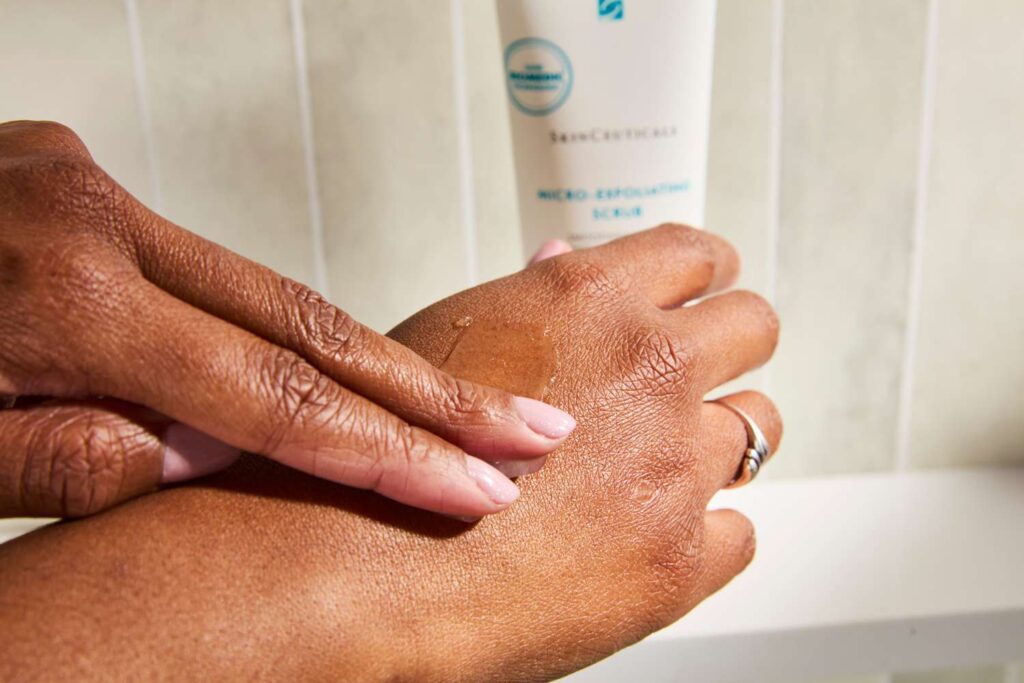An exfoliating scrub can feel like magic in a jar buffing away dead skin, smoothing texture, and revealing a brighter, fresher complexion. But when misused, it can cause irritation, redness, or even microtears. In this comprehensive guide, you’ll learn everything you need: types of scrubs, how to use them correctly, what to look for in ingredients, and safe DIY recipes. We’ll also include expert tips, internal links, external citations, and a full FAQ section with schema markup. Let’s glow.

What Does an Exfoliating Scrub Do?
Exfoliation is the process of removing dead skin cells from the surface of your skin. An exfoliating scrub accelerates that process, helping to:
- Brighten dull skin
- Smooth rough texture
- Unclog pores and reduce breakouts
- Improve absorption of serums and moisturizers
- Even out skin tone and promote healthy skin cell turnover
Types & Mechanisms of exfoliating scrubs
Not all scrubs are created equal. Understanding the differences will help you select the safest and most effective option.
Physical (Mechanical) of exfoliating scrubs
These use small, gritty particles to physically “scrub” away dead skin. Common abrasives include:
- Sugar grains
- Salt crystals (coarse or fine)
- Jojoba beads
- Ground walnut shells or almond meal
Enzymatic & Chemical Scrubs
Rather than physical abrasion, these scrubs use enzymes or mild acids to dissolve dead skin cells:
- Fruit enzymes (papain from papaya, bromelain from pineapple)
- Alpha hydroxy acids (AHA) like glycolic or lactic acid
- Beta hydroxy acid (BHA), especially salicylic acid
These scrubs are gentler and more suitable for sensitive or aging skin.
Hybrid exfoliating Scrubs
Some formulations combine fine physical particles with gentle chemical exfoliants. This can give a balanced effect light abrasion plus enzymatic action for deeper results.
How to Choose a Suitable Exfoliating Scrub for Your Skin Type
Matching scrub strength and formula to your skin’s tolerance is crucial. Here’s a quick guide:
| Skin Type / Concern | Ideal Scrub Type / Features |
|---|---|
| Sensitive / Dry | Enzymatic or very fine sugar scrub with calming agents (like aloe, ceramides) |
| Normal / Combination | Gentle physical scrubs 2x week or hybrid scrubs |
| Oily / Acne-prone | BHA-based scrubs or fine-grain physical scrubs, used 2–3 × week |
| Aging / Dull Skin | AHA or enzymatic scrubs to reduce dullness and texture |
Always patch‑test new scrubs before full use.
How to Use an Exfoliating Scrub Safely
Using a scrub effectively is just as important as choosing a good one. Follow these steps:
- Cleanse first: Remove makeup, dirt, and oils.
- Dampen the skin: Slightly damp skin helps the scrub spread smoothly.
- Apply gently: Use light pressure and circular motions for 30–60 seconds.
- Avoid sensitive zones: Steer clear of eyelids, active breakouts, or broken skin.
- Rinse thoroughly: Use lukewarm water to rinse off all particles.
- Moisturize immediately: Follow with a hydrating moisturizer (serum + cream).
- Use sunscreen the next day: Exfoliated skin is more vulnerable to UV damage.
Experts warn that overuse, harsh pressure, or skipping after‑care can injure the skin barrier.
DIY & Natural exfoliating scrubs Recipes
If you prefer a more natural or budget friendly approach, here are a few easy, skin-safe recipes:
Brown Sugar & Honey Scrub
- 2 tbsp brown sugar
- 1 tbsp raw honey
Mix and apply gently. Sugar crystals exfoliate, while honey hydrates and balances.
Oatmeal & Yogurt Gentle exfoliating scrubs
- 2 tbsp finely ground oatmeal
- 2 tbsp plain yogurt (unsweetened)
Let it sit on skin for 5–10 minutes before rinsing. Great for sensitive skin.
Coffee & Coconut Oil exfoliating scrubs
- 2 tbsp used (dry) coffee grounds
- 1 tbsp coconut oil
Coffee acts as a mild abrasive and boosts circulation; coconut oil moisturizes.
Papaya Enzyme Mask
- 2–3 tbsp mashed ripe papaya
Apply for 10–15 minutes. Papain gently “dissolves” dead cells without rubbing.
When using fresh or perishable ingredients (like yogurt or fruit), store in the fridge and use within a few days.
Common Exfoliating Scrub Mistakes to Avoid
Even the best exfoliating scrub can backfire if misused. Here’s what to watch out for:
- Scrubbing too hard – causes micro-tears and redness.
- Skipping moisturizer – leaves your skin dry and flaky.
- Mixing acids and scrubs – can over-exfoliate your skin.
- Using dirty tools – spreads bacteria.
- Exfoliating sunburned skin – delays healing.
✅ Always patch test a new scrub before using it on your face and for better result use it with Exfoliating Gloves.
FAQs About Exfoliating Scrubs
1. Can I use an exfoliating scrub daily?
No, daily exfoliation can damage your skin barrier. Stick to 1–3 times a week depending on your skin type.
2. Should I exfoliate before or after cleansing?
Always exfoliate after cleansing, so you’re working on a clean surface.
3. Is exfoliating scrub good for acne?
Yes, but choose a gentle BHA exfoliant that unclogs pores without harsh scrubbing.
4. What’s better physical or chemical exfoliation?
It depends on your skin type. Physical scrubs suit normal/oily skin, while chemical exfoliants are better for sensitive or acne-prone skin.
5. Can I exfoliate if I have sensitive skin?
Yes, just opt for enzyme-based or very mild chemical exfoliants.
Conclusion: Reveal Your Healthiest Skin Yet with exfoliating scrubs
A good exfoliating scrub is your shortcut to brighter, smoother, and healthier skin. Whether you prefer a gentle chemical exfoliant or a natural sugar scrub, consistency is key.
Remember — exfoliation isn’t about harsh scrubbing; it’s about balance. Treat your skin kindly, listen to its needs, and always follow up with hydration and SPF.
✨ Ready to glow? Explore top-rated exfoliating scrubs and start your journey to radiant skin today at Amazon.
